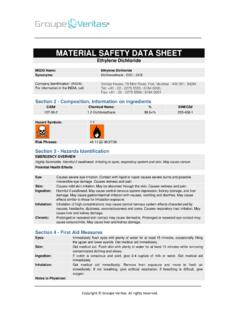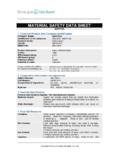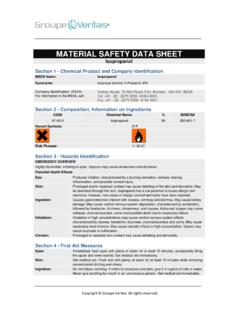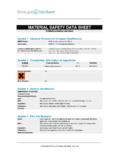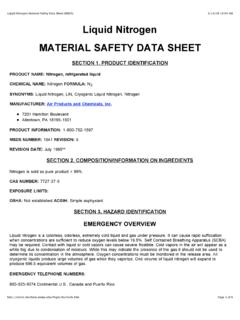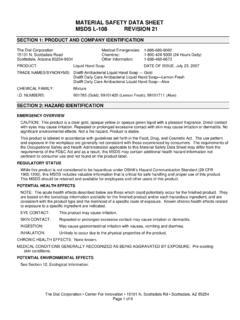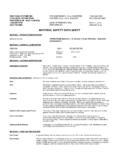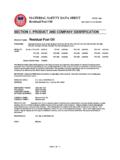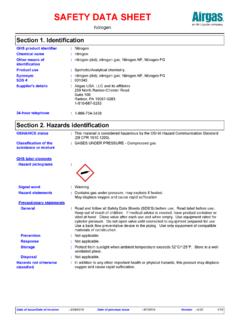Transcription of Material Safety Data Sheet
1 Material Safety data Sheet Anhydrous Ammonia MSDS Name: Anhydrous Ammonia Trade Name AMMONIA. Synonyms: Anhydrous Ammonia, Liquefied ammonia, Ammonia Chemical Name AMMONIA. Chemical Formula NH3. Chemical Family Alkali Material Uses Agricultural industry: Fertilizer. Industrial applications: Manufacture of chemicals, synthetic fibers, cleaning solutions, and specialty fertilizers. COMPANY IDENTIFICATION: (INDIA) VERITAS HOUSE, 70 MINT ROAD, FORT, MUMBAI - 400 001. INDIA. FOR INFORMATION IN THE INDIA, TEL: +91 - 22 - 2275 5555 / 6184 0000, CALL: FAX: +91 - 22 - 2275 5556 / 6184 0001. Section 2: Hazardous Identification Hazardous INgredient wt%. Ammonia Ammonia gas or liquid is very corrosive to body tissues, reacting with body moisture on contact. Inhalation: The odour recognition threshold for ammonia ranges from PPM for persons with an acute sense of smell to over 50 PPM for acclimatized individuals. Generally, concentrations of up to 25 PPM are tolerated although unpleasant and pungent.
2 Above this concentration, irritation of the eyes, nose and throat may begin. The extent of irritation increases with increasing ammonia concentration, and decreases with acclimatization NIOSH has established 300 PPM as the concentration immediately dangerous to life and health (IDLH), which is defined as the concentration above which self-rescue may be difficult or impossible due to physiological effects. At concentrations above 1000 PPM increasing chest tightness, brochospasm and severe eye and skin irritation may result. Delayed effects such as chemical pneumonitis and pulmonary edema may develop several hours after exposure. Exposure to high concentrations (5,000 ppm) may cause death. Effects may be more pronounced at lower concentrations in children, the elderly, and persons with impaired lung function Eyes: Exposure to high gas concentrations may cause temporary or permanent eye damage. Direct contact of the eyes with liquid ammonia will produce serious eye burns.
3 Excessive exposure to gaseous or liquid ammonia may result in permanent blindness Skin: Contact with liquid or high concentrations of gas may cause severe skin irritation, chemical burns, and blistering. Contact with vaporizing liquid may cause frostbite due to rapid evaporative cooling. Cooling effect may mask the extent of the corrosive injury received. Ingestion: Ingestion is not a likely route of exposure due to the physical state of the substance (a compressed, liquefied gas). CARCINOGENIC EFFECTS: NONE by ACGIH, EPA, IARC, OSHA. MUTAGENIC EFFECTS: NONE by ACGIH, EPA, IARC, OSHA. TERATOGENIC EFFECTS: NONE by ACGIH, EPA, IARC, OSHA. The substance is harmful to the lungs and mucous membranes. Repeated or prolonged exposure to the substance can produce target organ damage. Sub-acute and chronic exposures to concentrations of 100-200 ppm may result in eye irritation while concentrations of 200-1000 ppm may produce eye damage. POTENTIAL CHRONIC HEALTH EFFECTS POTENTIAL ACUTE HEALTH.
4 EFFECTS. COPYRIGHT GROUPE VERITAS. ALL RIGHTS RESERVED. SECTION 3: First Aid Measures: EYE CONTACT / SKIN CONTACT: Immediately flush eyes with water for 60 minutes or longer keeping eyelids open. Obtain immediate medical attention. Continue to flush eyes, if possible, while transporting to medical care. Dermal contact may freeze tissue and cause severe skin irritation or chemical burns. Immediately flush with water for a minimum of 60 minutes while removing contaminated clothing. Obtain immediate medical attention. Continue to flush, if possible, while being transported to medical care. INHALATION: Loosen tight clothing. Allow to rest in a well ventilated area. Give artificial respiration if breathing has stopped. Obtain immediate medical attention. If gases or vapors are present, rescuers must wear self-contained breathing apparatus and an impervious (Level A) encapsulating suit if subject to US OSHA requirements. (29 CFR has been deemed to overrule the lesser protection requirements given in ) In other jurisdictions or if responding under rules (49 CFR) full bunker gear or Level B clothing may suffice.
5 Evacuate affected persons to a safe area as soon as possible. Loosen tight clothing around the neck and waist. If the person is not breathing, perform artificial respiration. If breathing is difficult, administer oxygen. Maintain an open airway. Obtain immediate medical attention. Observation may be warranted. Pulmonary edema may occur several hours after exposure. INGESTION: If anhydrous ammonia has entered the mouth or throat, begin resuscitation or artificial respiration avoiding mouth to mouth contact and continue until the person is breathing. Administer oxygen if available. Do not induce vomiting. Quickly transport the person to an emergency care facility. Removal of the substance from the stomach must be done by medical personnel. If tolerated, give no more than 1 cup of milk or water to rinse the mouth and throat and dilute the stomach contents. No more than 8 ounces (1 cup). in adults and 4 ounces (1/2 cup) in children is recommended to minimize the risk of vomiting.
6 If spontaneous vomiting does occur, lower the head so that the vomit will not reenter the mouth and throat. Rinse mouth with water. Section 4. Fire and Explosion data The product is Combustible. Product will burn with difficulty if kept between the LEL of 16% and UEL of 25%. This gas is generally regarded as non-flammable due to the difficulty of ignition. However, the presence of oil or other combustible materials will increase the fire hazard, and may ignite with explosive force under favorable conditions. Nitrogen oxides (NO, NO2). Auto-ignition temperature C (1204 F). Products of combustion Not applicable Flash point Material exists as a gas unless confined under pressure Flammability limits LOWER: 16%. UPPER: 25%. Fire hazard in the presence of May ignite in the presence of open flames and sparks. Narrow various lower to upper flammability limits (16-25%) makes ignition difficult Substances but not impossible. The presence of oil or other combustible materials will increase the fire hazard.
7 Explosion hazard in the presence of Slightly explosive in the presence of reducing materials various substances (hypochlorites or other halogenated compounds). Ammonia is not readily ignited but a mixture of ammonia and air will explode when ignited under favorable conditions Fire fighting media and instructions Corrosive. If gases or vapours are present, rescuers must wear self-contained breathing apparatus and an impervious (Level A). encapsulating suit if subject to US OSHA. requirements. (29 CFR has been deemed to overrule the lesser protection requirements given in ) In other jurisdictions or if responding under rules (49 CFR) full bunker gear or Level B clothing may suffice. COPYRIGHT GROUPE VERITAS. ALL RIGHTS RESERVED. Approach from Upwind If anhydrous ammonia catches fire, stop flow of gas or liquid if it may be done safely. Cool containing vessels with water in order to prevent pressure build-up Autoignition or Explosion Move containing vessels from fire if without risk.
8 Use water fog to suppress vapors. Do not direct water into spilled ammonia. Ammonia is a cryogenic liquid which will cool with evaporation thereby limiting vapour release. Fire water at supply temperature will increase liquid ammonia's temperature resulting in greater evaporation. Contain run-off water for treatment. Hazardous Combustion Products: Nitrogen oxides EXPLOSION HAZARDS Explosive when mixed with chlorinated materials such as hypochlorites. Will form nitrogen trichloride which explodes spontaneously in air. Ammonia reacts similarly with other halogenated materials FIRE HAZARDS When heated to decomposition it emits toxic fumes Section 5. Accidental Release Measures SMALL SPILL: Warn personnel to move away. Keep unprotected personnel upwind of spill area. Do not approach liquid or vapor cloud without encapsulating suit and SCBA. If possible to do so without hazard, isolate leak by shutting off supply of ammonia from containing vessel. Use water fog to suppress airborne vapors from leak or spill.
9 Do not direct water into spilled liquid! Anhydrous ammonia will autorefrigerate reducing vapor release. Addition of water will warm cryogenic liquid resulting in greater gasification. Contain run-off water for later recovery and treatment. Call emergency number on this MSDS Sheet for assistance. LARGE SPILL: Stay indoors (unless evacuation has been called by local authorities). Close all windows and doors, seal with duct tape or wet towels Shut off furnace, exhaust fans, fireplaces, and air conditioners Wait for and follow advice from local police or authorities If smell is very strong, breath through a wet cloth PRECAUTIONS Keep ammonia handling facilities and containers locked. Protect against physical damage. Keep storage vessels away from direct heat. Ground all equipment. Keep away from incompatible materials such as oxidizing agents, reducing agents, metals, and acids. Keep children away from ammonia storage and handling equipment. Section 6. Handling and Storage STORAGE: Keep away from combustible materials, heat, and incompatible materials, especially dry or liquid bleach.
10 Ensure facilities are well maintained and emergency response and first aid equipment is readily available. Always ensure there is a nearby source of water for first aid purposes and spill response. Handling: Facilities storing or handling ammonia should be equipped with an eyewash and Safety shower, or other equipment for emergency decontamination COPYRIGHT GROUPE VERITAS. ALL RIGHTS RESERVED. Section 7. Exposure Controls/Personal Protection ENGINEERING CONTROLS Workers must be trained in the safe handling and use of ammonia. Adequate, well engineered systems must be provided for storage, transfer and use. Process block valves, equipment enclosures and other isolation facilities may be necessary. Provide adequate general or local exhaust systems to maintain concentrations within exposure guidelines. PERSONAL PROTECTION The selection of personal protective equipment varies, depending upon conditions of use. Respiratory Protection: Use a NIOSH approved chemical cartridge respirator with full facepiece for ammonia concentrations up to 300 PPM.
